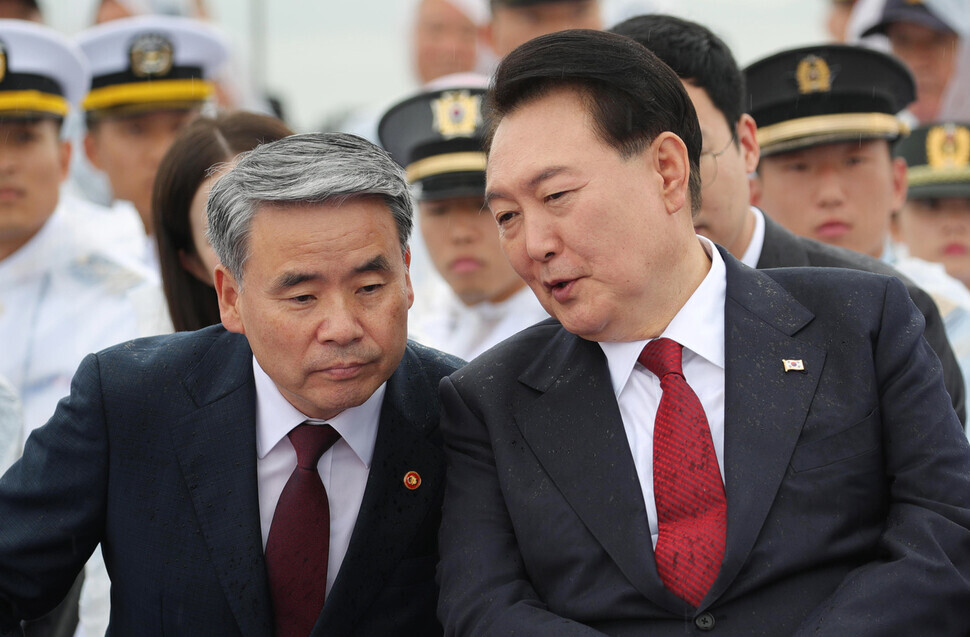hankyoreh
Links to other country sites 다른 나라 사이트 링크
[Editorial] Why is the Yoon administration overreaching to shield the former defense minister from a criminal investigation?

Former Minister of National Defense Lee Jong-sup, the key suspect in a case of alleged external pressure concerning an investigation into the suspicious death of a marine, has left South Korea.
This happened thanks to an organized and systematic effort by multiple state institutions to pave the way for his departure, from the president appointing him as ambassador to Australia on Mar. 4 to a mere half-day of questioning by the Corruption Investigation Office for High-ranking Officials (CIO) on Mar. 7 – not to mention the Ministry of Justice (MOJ) lifting a travel ban the next day.
The MOJ’s action in lifting the ban was a clear-cut case of preferential treatment, as it accepted the suspect’s appeal despite the objections of the CIO. This sort of ill-considered move will only fuel the allegations.
Lee is suspected of exercising influence in the Marine Corps investigators’ probe into the death of a corporal who drowned during a flood rescue mission last year. He is also a key witness in a position to share information on possible involvement higher up the chain by the presidential office.
As the investigation gathered steam last January, the CIO imposed an exit ban on Lee to prevent him from leaving the country. To send him overseas as ambassador to Australia constitutes obstruction of an investigation. This action alone may be seen as unconstitutional.
The presidential office claimed it was “unaware” that the ban had been in place. That’s unbelievable enough in the first place, but nothing changed after the office found out.
What was the MOJ doing as the agency in charge of both the exit ban and primary vetting duties? Not only that, but there was no precedent for an exit ban being lifted in response to an appeal like the one Lee submitted after being appointed ambassador.
In 2007, research fellows Lee Seung-hyeon and Kim Dae-geun from the Korea Institute of Criminology and Justice published a report titled, “Problems with the Current Exit Ban System and Avenues for Improvement.” The researchers observed that among the 236 exit ban appeals submitted in 2016, 229 were rejected — a denial rate of 97%. Since almost no appeals by suspects were approved, most of them went the route of administrative hearings and administrative suits.
As a general rule, exit bans are not lifted while an investigation is ongoing except in cases of humanitarian grounds such as weddings or funerals in the family.
It was extremely inappropriate for the MOJ to lift Lee’s ban in spite of the CIO’s opposition to the measure. The CIO had planned to question Lee after completing its interrogation of subordinates such as Marine Corps Commandant Kim Gye-hwan.
The mere half-day of questioning that Lee volunteered for is unlikely to have been of any help at all to the investigation. On that basis, the CIO stated its opposition to lifting the exit ban, but the MOJ disregarded such concerns. The MOJ probably would not have been so lax had the objections come from prosecutors.
It looks as though the presidential office and the MOJ are doing everything possible to avoid an investigation into the causes and responsible parties behind Corporal Chae’s death.
Please direct questions or comments to [english@hani.co.kr]

Editorial・opinion
![[Column] Season 2 of special prosecutor probe may be coming to Korea soon [Column] Season 2 of special prosecutor probe may be coming to Korea soon](https://flexible.img.hani.co.kr/flexible/normal/500/300/imgdb/original/2024/0426/3317141030699447.jpg) [Column] Season 2 of special prosecutor probe may be coming to Korea soon
[Column] Season 2 of special prosecutor probe may be coming to Korea soon![[Column] Park Geun-hye déjà vu in Yoon Suk-yeol [Column] Park Geun-hye déjà vu in Yoon Suk-yeol](https://flexible.img.hani.co.kr/flexible/normal/500/300/imgdb/original/2024/0424/651713945113788.jpg) [Column] Park Geun-hye déjà vu in Yoon Suk-yeol
[Column] Park Geun-hye déjà vu in Yoon Suk-yeol- [Editorial] New weight of N. Korea’s nuclear threats makes dialogue all the more urgent
- [Guest essay] The real reason Korea’s new right wants to dub Rhee a founding father
- [Column] ‘Choson’: Is it time we start referring to N. Korea in its own terms?
- [Editorial] Japan’s rewriting of history with Korea has gone too far
- [Column] The president’s questionable capacity for dialogue
- [Column] Are chaebol firms just pizza pies for families to divvy up as they please?
- [Column] Has Korea, too, crossed the Rubicon on China?
- [Correspondent’s column] In Japan’s alliance with US, echoes of its past alliances with UK
Most viewed articles
- 1‘We must say no’: Seoul defense chief on Korean, USFK involvement in hypothetical Taiwan crisis
- 2[Editorial] Korea’s surprise Q1 growth requires objective assessment, not blind fanfare
- 3Division commander ordered troops to enter raging flood waters before Marine died, survivor says
- 4[Column] Season 2 of special prosecutor probe may be coming to Korea soon
- 5Is Japan about to snatch control of Line messenger from Korea’s Naver?
- 6S. Korea “monitoring developments” after report of secret Chinese police station in Seoul
- 7No good, very bad game for Korea puts it out of Olympics for first time since 1988
- 8The dream K-drama boyfriend stealing hearts and screens in Japan
- 9[Column] ‘Choson’: Is it time we start referring to N. Korea in its own terms?
- 10Is N. Korea threatening to test nukes in response to possible new US-led sanctions body?